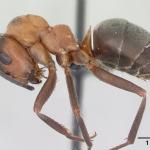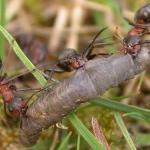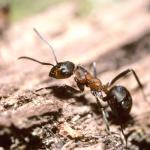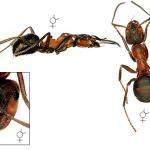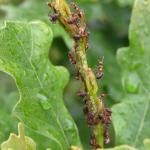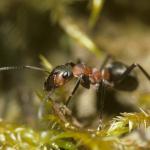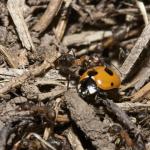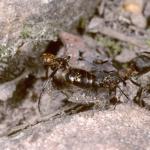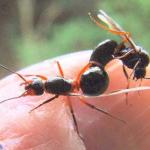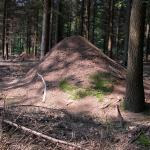Formica rufa is one of four British species of 'wood ant' and is confined to England and Wales. There is some indication that there has been a contraction of the range of F. rufa, especially in northern, central and eastern England and parts of Wales. In many parts of its southern range the species is, however, still locally common and even expanding. The apparent indication of a contraction of the range may be due, in part, to a lack of recording effort in certain areas. Comparing this map (Ed. the one published in Edwards 19??) with that for post-1961 records produced by Barrett in 1979, the main areas for increased recording effort would appear to be: Cumbria; the Forest of Dean and English/Welsh border counties; Berkshire and Hampshire and parts of East Sussex and east Surrey (these last four counties are not usually noted for their lack of records). There is also a possibility that some of the historical records for this species in northern and central Britain have arisen through confusion with Formica lugubris (there is, in fact, an overlap of the two species in northern England). Confirmation of these is needed although the possibility that F. lugubris has taken over some sites from F. rufa should not be ruled out.
This is not a listed species, but the main threats to F. rufa appear to be the loss and fragmentation (through agricultural and urban development) or inadequate management of suitable natural or semi-natural woodland. A series of poor summers and deliberate or accidental damage to nests may be enough to destroy an isolated and vulnerable colony, and this has undoubtedly occurred at some of its former sites. The fortunes of the species may also change with the structure and density of tree cover at any site. The species can expand into developing scrub and also plantation forestry but only if the latter is appropriately designed, managed, exploited and close to an existing population.
Taxonomic status
Some British myrmecologists, notably Cedric Collingwood, long maintained that the wood ants of S Britain (England and Wales), retaining the name “Formica rufa, Linnaeus 1761” following the revision of Yarrow (1955), did not conform morphologically or behaviourally to the wood ants known by that name in continental Europe. Continental F. rufa was observed as being typically larger and hairier, nesting in isolated single mounds hostile to neighbours (monodomous), single-queened (monogynous), and reproducing mainly by temporary social parasitism of Serviformica ants.. British “F. rufa” is much less hairy, smaller, and lives mostly in mutually friendly, interconnected nests (polydomous) each containing many queens (polygynous), and reproducing mostly by colony fission (“budding”). In 2010, samples gathered from sites across the range of “F. rufa” in England & Wales were subjected to morphometric analysis by Seifert et al. (2010), alongside continental samples, which showed that phenotypically all the British ants were intermediate between F. rufa and F.polyctena, a common continental species not recorded in Britain. Similar forms were identified among the continental samples, and genetic analysis of the German intermediates showed a hybrid status between rufa and polyctena. A suggested hypothesis for selection of the ‘hybrid’ was as a response to extreme forest fragmentation, a very plausible argument in Britain’s case. Seifert’s recent 2021 revision of the Palaearctic F. rufa group reaffirms this scenario, whilst acknowledging that British samples have a smaller mean size and shorter gular setae than the continental version. A genetic analysis is much needed to clarify the relationship.
References
Seifert, B., Kulmuni, J. & Pamilo, P., (2010). Independent hybrid populations of Formica polyctena x rufa wood ants (Hymenoptera: Formicidae) abound under conditions of forest fragmentation. Evolutionary Ecology, 24: 1219–1237.
Seifert, B., (2021). A taxonomic revision of the Palaearctic members of the Formica rufa group (Hymenoptera: Formicidae) – the famous mound-building red wood ants. Myrmecol. News, 31: 133-179.
Yarrow, I.H.H., (1955). The British Ants allied to Formica rufa L., (Hym., Formicidae). Trans. Soc. Brit. Ent. 12: 1-48.
Deciduous, mixed and coniferous woodlands; occasionally spreading out on to scrubby heath, open rides and verges.
May - June
The large nest mounds of wood ants will be familiar to many people. They are composed of fragments of vegetation collected by the ants. There may be up to 400,000 individuals in a nest. Occasionally, several nests may be interconnected, forming one large colony. Where the species is present in any numbers it can have a significant influence on the ecology of its woodland habitat. The ants are major predators and scavengers of woodland insects and feed extensively on aphid honeydew. Their colonies also support a wide range of often rare myrmecophilous arthropods. New colonies are established by the fission of colonies with more than one queen; there is also occasional founding by newly mated queens of colonies with other Formica species through semi-social parasitism.
2021


